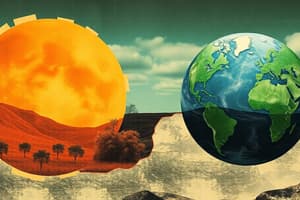Podcast
Questions and Answers
What does weather describe?
What does weather describe?
- The atmospheric pressure
- The long-term climate patterns
- The condition of the atmosphere over a short period of time (correct)
- The movement of air in the sky
What affects the earth's temperature, in addition to heat energy from the sun?
What affects the earth's temperature, in addition to heat energy from the sun?
- The amount of water vapor in the air
- The weight and density of the air
- The movement of air in the sky
- Human activities like releasing greenhouse gases (correct)
What causes wind?
What causes wind?
- The movement of water vapor
- The weight and density of the air
- Cloud formation
- Different air pressures in the atmosphere (correct)
What is humidity a measure of?
What is humidity a measure of?
What is atmospheric pressure a result of?
What is atmospheric pressure a result of?
Temperature describes how hot or cold the ______ is
Temperature describes how hot or cold the ______ is
Atmospheric pressure changes as air becomes ______ or colder
Atmospheric pressure changes as air becomes ______ or colder
Clouds are visible masses of water vapour in our ______
Clouds are visible masses of water vapour in our ______
Wind is caused by the different air pressures in our ______
Wind is caused by the different air pressures in our ______
Humidity describes the amount of water vapor in the ______
Humidity describes the amount of water vapor in the ______
Flashcards
What does weather describe?
What does weather describe?
The condition of the atmosphere over a short period of time.
What affects Earth's temperature besides the sun?
What affects Earth's temperature besides the sun?
Human activities like releasing greenhouse gases.
What causes wind?
What causes wind?
Different air pressures in the atmosphere.
What is humidity a measure of?
What is humidity a measure of?
Signup and view all the flashcards
What causes atmospheric pressure?
What causes atmospheric pressure?
Signup and view all the flashcards
Temperature describes...
Temperature describes...
Signup and view all the flashcards
Atmospheric pressue changes when the air becomes...
Atmospheric pressue changes when the air becomes...
Signup and view all the flashcards
Clouds are...
Clouds are...
Signup and view all the flashcards
Study Notes
Weather Basics
- Weather describes the condition of the atmosphere at a particular place and time, including temperature, humidity, cloudiness, wind, and atmospheric pressure.
Factors Affecting Earth's Temperature
- The Earth's temperature is affected by heat energy from the sun, as well as the atmosphere's natural greenhouse effect.
Wind Formation
- Wind is caused by the difference in air pressure in the atmosphere, resulting in air moving from high-pressure areas to low-pressure areas.
Humidity and Atmospheric Pressure
- Humidity is a measure of the amount of water vapor in the air.
- Atmospheric pressure is a result of the weight of the air in the atmosphere, which increases with height.
Temperature and Atmospheric Pressure
- Temperature describes how hot or cold the air is.
- Atmospheric pressure changes as air becomes warmer or colder, with pressure decreasing as air rises and increasing as air sinks.
Clouds and Wind
- Clouds are visible masses of water vapor in our atmosphere.
- Wind is caused by the different air pressures in our atmosphere.
Studying That Suits You
Use AI to generate personalized quizzes and flashcards to suit your learning preferences.




